Down on the Farm with Seal
by SealWyf, HSM Editor
How ya gonna keep ‘em down on the farm
After they’ve seen Paree?
That’s a very good question. However, we saw Paris (in the form of Granzella’s “City of Flowers” apartment) before we got Juggernaut’s Bramblenook Farm, and frankly the farm is better. Juggernaut can pack more sheer awesome into a chunk of memory than any developer I know, although as “City of Flowers” demonstrates, that bar is steadily being raised throughout Home.
Juggernaut’s new personal space is a very impressive apartment — large and interactive, with well-rendered details, customize-able time-of-day, and a symphonic soundtrack that owes much to Aaron Copland and Ralph Vaughan Williams, and is well worth listening to.
As an apartment, it’s fully worth the purchase price. But I think most of us got it for the embedded game. Farm games, and accumulation games in general, are a popular genre. And they are starting to edge their way into Home, with variable success — in Home Tycoon, FUBAR, and now Bramblenook Farm. Those of us who love a good accumulation game are hoping that Home will provide us with our “killer app”.
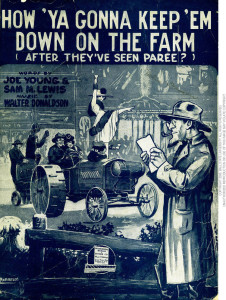 For the few of you who have been living under a rock the past week or so, here’s a summary of Bramblenook’s gameplay.
For the few of you who have been living under a rock the past week or so, here’s a summary of Bramblenook’s gameplay.
In-game cash, “gold”, can be earned in the farm though various game activities. Contrary to my initial guess, you cannot simply purchase it, and I have rarely been so glad to have a guess proved wrong. Gold must be earned, and there are three ways to earn it.
The first way (literally the first, because the other two require gold to get started) is to craft and sell furniture. Crafting furniture takes a supply of wood, and in most cases, additional gold. You get wood by playing the wood-splitting mini-game, whacking the X button as the moving cursor passes over the “sweet spot”. It’s not as easy as it looks, because the cursor speeds up as you continue. While getting five consecutive splits is no problem, getting ten takes some practice, and the most I have ever gotten is twelve.
Whatever your skill level, eventually you chop a bunch of wood. Then you move to the wood-crafting table to make and sell furniture items. The only item that does not take additional cash is the Rustic Bucket, which will net you one gold when you sell it. So you start by making a whole lot of buckets. (Humming “The Old Oaken Bucket” while doing so is an optional activity.)
Crafting items increases your skill level and, since this is an accumulation game, unlocks other items to craft. A great side-effect of item-crafting is that you also receive each item for decorating purposes, both as a conventional inventory item and as a special item that can be placed in the Bramblenook Farm apartment without using any furniture slots at all. Which is the good side of using them — the bad side is that it’s much harder to position these things precisely. It’s probably best to leave them scattered around outside the house, where their exact position is not important.
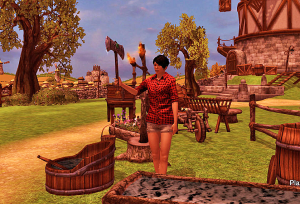 After you have some gold, you can start in on the other two cash-making activities — raising crops and rearing animals. Crops take less gold to get started. They also mature quickly, and they sell for a tidy profit. In no time at all, you have graduated from one plot of budget Turnips to a full 15-plot field of profitable Corn.
After you have some gold, you can start in on the other two cash-making activities — raising crops and rearing animals. Crops take less gold to get started. They also mature quickly, and they sell for a tidy profit. In no time at all, you have graduated from one plot of budget Turnips to a full 15-plot field of profitable Corn.
Making the crops grow requires watering them once, and then waiting for the proper number of minutes. You don’t have to stay in the apartment while the crops mature. But if you do, this is a good time to catch up on your wood-chopping chores. You’ll be chopping a lot of wood before you’re done, and it doesn’t hurt to build your woodpile whenever you have a few spare minutes.
Rearing animals works in much the same way. You purchase chicks, piglets and lambs from the Farm Ledger in the house, then feed them and let them grow. Each animal must be fed a total of three times, and can require several hours to reach full maturity. At that point you can sell them for a nice profit and buy more livestock. It doesn’t take long at all to get a full set of five of each beast.
At this point, your farm is essentially complete. You may still be working on unlocking furniture items (I know I am), but the end is very much in sight. You can accumulate more gold, but there is little point to it. There is nothing you can spend it on except more seeds and baby animals. Once you have accumulated several thousand gold, you are pretty much done.
And so the Bramblenook Farm game ends with something very like a dull thud. The old song about the relative merits of farms and Paris might well be rewritten,
How’ ya gonna keep ‘em down on the farm
After they’ve maxed the game?
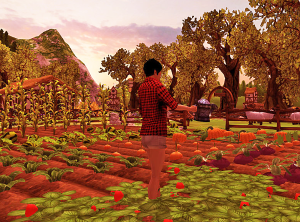 There is still the apartment side of the property, of course. And it’s a lovely one. There is plenty of room here for decoration, especially since you can supplement your normal furniture items with rustic home-made crafts. And there are worse uses of a field of crops and a gaggle of animated animals than providing bucolic rural scenery.
There is still the apartment side of the property, of course. And it’s a lovely one. There is plenty of room here for decoration, especially since you can supplement your normal furniture items with rustic home-made crafts. And there are worse uses of a field of crops and a gaggle of animated animals than providing bucolic rural scenery.
But one does wish the game would continue.
In my anticipatory review of Bramblenook Farm, I speculated that it might be similar to classic farm and accumulation games such as Harvest Moon and Animal Crossing. That was probably unrealistic. There is only so much stuff that any developer, even Juggernaut, can pack into a chunk of memory. But there are some ways that the game might be enlarged.
What follows are the speculations of a gamer who has only rudimentary ideas about the technical problems involved. But this is not entirely a technical problem. It is also a problem of game design and storytelling. And I do sincerely believe that one is a subset of the other.
What keeps us engaged as gamers? In the broadest sense, a game is a symbolic activity that provides the player with goals and challenges. The goal of Bramblenook Farm is to complete the game — build all the furniture, raise all the crops and rear all the animals. But that is the only goal, and it is easily attained. All it requires is a little perseverance.
By contrast, I would like to point to one of the best Home games (and, ironically, one of the earliest), Lockwood’s Salt Shooter. That game has three distinct goals. The most obvious one is completing all the levels. (It’s no easy task — I’m still stuck on Level 50.) But there are two additional goals, which can keep a player engaged even after they have won the final jacket. You can maximize your score on each level and climb the leaderboard. (In other words, see if you can beat Grimm.) You can also accumulate resource items to sell for Sodium Credits, and exchange the credits for exclusive virtual goods. Some of these were extremely expensive and extremely desirable. I swear that someday I’ll earn my Golden Vickie.
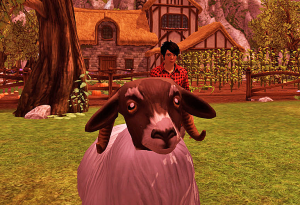 The point is, Salt Shooter stays fresh because, first, it’s a truly awesome game and, second, the goals are pretty much open-ended. Very few people manage to complete all fifty levels, top the leaderboards, and buy everything in Vickie’s virtual storefront.
The point is, Salt Shooter stays fresh because, first, it’s a truly awesome game and, second, the goals are pretty much open-ended. Very few people manage to complete all fifty levels, top the leaderboards, and buy everything in Vickie’s virtual storefront.
Could Bramblenook Farm use a similar strategy to keep us engaged? I don’t see leaderboards as an option (for one thing, they would not fit into the pastoral mood.) But there are other ways to make the game open-ended.
Looking across the water, we see a village surrounding a Medieval castle. To me, this suggests a related public space — one that can only be reached (or at least only fully experienced) by people who own the apartment. (Think x7 for rustic farm hands.) A village would give us a place to spend our hard-earned farm income. Like every worthwhile Medieval village, it would have a marketplace, a tavern and a country fair.
Fairs have games of skill — Medieval midways — where we could spend our surplus in-game gold. The market would have things to buy, and here the in-game gold could be mixed with real-world PSN dollars. Because, of course, all this needs to be monetized, or it won’t happen. But I think we would be happy to pay some cash for, say, a draft horse locomotion, or an active-item apple tree that goes through a flower-and-fruit cycle, or an Artisanal Bow that will increase our chance of winning the archery game in the Fair.
So far, I’ve been talking about goals — reasons to keep playing the game. But what about that other feature of games — challenges? Games aren’t fun unless they make us work to win them. This is one of the ways that games are a form of story-telling. You need to have adversity before you get to happy-ever-after.
One thing I quickly noticed in Bramblenook Farm is that there are no crop failures. I’m only a couple of generations off a real-world farm myself, and I know that it’s a hard life, not a gentleman’s recreation. There’s a lot more to raising a crop than sticking seeds in the ground and sprinkling them with a watering can.
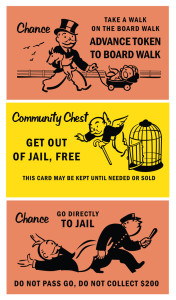 What if Bramblenook Farm became more challenging? The only real challenge we have is the wood-chopping game, and that’s just a matter of perseverance. You can be terminally clumsy, but eventually the wood gets chopped. You can be humiliated by your ineptitude, but you can’t really lose.
What if Bramblenook Farm became more challenging? The only real challenge we have is the wood-chopping game, and that’s just a matter of perseverance. You can be terminally clumsy, but eventually the wood gets chopped. You can be humiliated by your ineptitude, but you can’t really lose.
But what if there was a way to fail?
I’m thinking something along the line of random Monopoly events — the Chance and Community Chest cards — which can be good or bad.
Here’s a scenario to think about. You purchase a Lucky Horseshoe active item and hang it above the farmhouse door. Once it’s in place, you can interact with it to set your “luck level”. If you turn it off, it’s just a decoration. But if you turn it on, every day when you arrive in the space, there will be a random event.
It could be good — a higher price for watermelons, for instance. Or it could be bad — your corn has been attacked by corn borers, and the whole crop has been ruined. If you hadn’t planted corn you would be spared, but maybe the next day’s event is a swarm of locusts that eats all your lettuce.
The Horseshoe would have three settings, as well as “Off”. The lowest setting would cause occasional small changes to crop generation time and sale price. The next higher setting would add some moderate swings of good or bad luck. Bad events might destroy a single crop, but good ones would give worthwhile rewards. Then there is the Extreme setting, which includes the small and moderate luck swings, but sometimes gives disasters or windfalls — complete crop failure on one hand, and fabulous wealth or rare exclusive items on the other. The Lucky Horseshoe would be, in effect, a gambling game with adjustable volatility.
It would be interesting to see how people set their luck levels. I think I would go for the Extreme setting, if only to see what the Horseshoe came up with. (“Invading barbarians steal all your furniture. Back to the woodpile!”) The Horseshoe and the Fair would add real goals and challenges to Bramblenook Farm, and turn it into more of a real game.
But these are just one virtual farmer’s dream. I’m sure you have other ideas for making the Farm more addictive. What would it take, to keep you “down on the farm”?
Share
| Tweet |


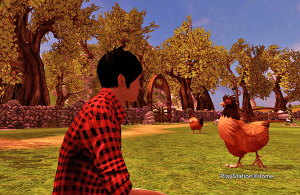
I haven’t had a chance to buy Bramblenook yet as I used all my allowance for the new (Awesome!) Tomb Raider game. Go! Buy!
I did get to go to the meet and greet with Juggernaut at the open house (farm) last week and these guys are looking for our input. A lot of people wanted to go to the castle. Another idea that was suggested to them was a for a market. I think if this was a public space for everyone, using gold coins from the farm or for purchase, that would great. It would encourage sales of the farm, too.
I often wonder as I’m chopping wood who in the community has chopped the most wood and who has maintained the 2x and 3x multiplier the longest.That could be an interesting stat.Who has the most gold could be another.I’ve always assumed the windmill would be opened up somehow,through tasks completed on the farm.The castle in the distance is interesting as is the river and the dock.Will I have to defend this spot at some point I wonder?(I’ve placed a cannon there just in case)and from what?Goblins?My neighbor?The house in the distance fly’s a white flag.Have they surrendered?To who or what?…and where are the Cows??A farm needs cows.I have one but it’s not a Bramblenook cow and it takes 22 slots.I hope updates to Bramblenoook will answer some of these questions.
I believe we will be able to fish in the river eventually, so that is one expansion that will probably occur. A public space would be nice too. I think they will also expand upon what we can build and sell and also what types of animals we can raise. All of these would be good, but like the others they would be easily obtained goals unless some factor changes that. I like your crop fail idea, that would make it so we would have to go back to our space regularly or risk losing them. I have noticed that you do have to feed the animals that are full grown occasionally, I go back there everyday to do all of mine just in case. Perhaps they could become ill and eventually disappear if we don’t tend them, like real animals would. What about adding egg gathering for the chickens? These are something you could sell for a small profit like real farms do. I finished my space entirely with all of the crops and animals in only two days, and I had it furnished as well. I love the space, I enjoy the music and the way the time of day changes how the entire space looks, but I do hope Juggernaut follows their usual pattern and updates it regularly. Nice read Seal.
ooo fishing in the river!great idea Burbie and great article SealWyf.another thing that could be updated is the front gate.standing there always gives me the impression that it will open up one day but where will it lead?I would love to be able to visit friends farms from this gate or go to a Bramblenook public space,such as a market.I like the idea of animals getting sick if they are not cared for,too.Right now I don’t think I can kill an animal through neglect but this could be a possible addition to the farm dynamic.